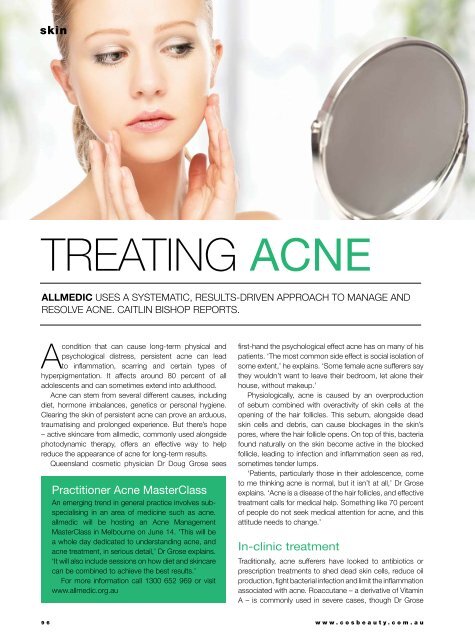Cosmetic Surgery and Beauty Magazine #64
Cosmetic Surgery & Beauty Magazine is the definitive guide to the aesthetic medicine industry for anyone considering a treatment therapy or surgical procedure. This quality quarterly publication contains comprehensive information about practitioners, equipment, techniques, processes and options, presented clearly and completely. The strong emphasis on input by industry professionals provides profiles of the practitioners and understanding of their approach to each procedure, enabling readers to make informed choices in their initial approaches to deciding what will best suit their needs. Hundreds of untouched before-and-after photographs provided by the practitioners themselves graphically illustrate both treatable conditions and the results that can be obtained. Cosmetic Surgery & Beauty Magazine is essential reading for anyone wishing to inform themselves about the options available in aesthetic medicine in Australia.
Cosmetic Surgery & Beauty Magazine is the definitive guide to the aesthetic medicine industry for anyone considering a treatment therapy or surgical procedure. This quality quarterly publication contains comprehensive information about practitioners, equipment, techniques, processes and options, presented clearly and completely. The strong emphasis on input by industry professionals provides profiles of the practitioners and understanding of their approach to each procedure, enabling readers to make informed choices in their initial approaches to deciding what will best suit their needs. Hundreds of untouched before-and-after photographs provided by the practitioners themselves graphically illustrate both treatable conditions and the results that can be obtained. Cosmetic Surgery & Beauty Magazine is essential reading for anyone wishing to inform themselves about the options available in aesthetic medicine in Australia.
Create successful ePaper yourself
Turn your PDF publications into a flip-book with our unique Google optimized e-Paper software.
skin<br />
Treating acne<br />
Allmedic uses a systematic, results-driven approach to manage <strong>and</strong><br />
resolve acne. Caitlin Bishop reports.<br />
A<br />
condition that can cause long-term physical <strong>and</strong><br />
psychological distress, persistent acne can lead<br />
to inflammation, scarring <strong>and</strong> certain types of<br />
hyperpigmentation. It affects around 80 percent of all<br />
adolescents <strong>and</strong> can sometimes extend into adulthood.<br />
Acne can stem from several different causes, including<br />
diet, hormone imbalances, genetics or personal hygiene.<br />
Clearing the skin of persistent acne can prove an arduous,<br />
traumatising <strong>and</strong> prolonged experience. But there’s hope<br />
– active skincare from allmedic, commonly used alongside<br />
photodynamic therapy, offers an effective way to help<br />
reduce the appearance of acne for long-term results.<br />
Queensl<strong>and</strong> cosmetic physician Dr Doug Grose sees<br />
Practitioner Acne MasterClass<br />
An emerging trend in general practice involves subspecialising<br />
in an area of medicine such as acne.<br />
allmedic will be hosting an Acne Management<br />
MasterClass in Melbourne on June 14. ‘This will be<br />
a whole day dedicated to underst<strong>and</strong>ing acne, <strong>and</strong><br />
acne treatment, in serious detail,’ Dr Grose explains.<br />
‘It will also include sessions on how diet <strong>and</strong> skincare<br />
can be combined to achieve the best results.’<br />
For more information call 1300 652 969 or visit<br />
www.allmedic.org.au<br />
first-h<strong>and</strong> the psychological effect acne has on many of his<br />
patients. ‘The most common side effect is social isolation of<br />
some extent,’ he explains. ‘Some female acne sufferers say<br />
they wouldn’t want to leave their bedroom, let alone their<br />
house, without makeup.’<br />
Physiologically, acne is caused by an overproduction<br />
of sebum combined with overactivity of skin cells at the<br />
opening of the hair follicles. This sebum, alongside dead<br />
skin cells <strong>and</strong> debris, can cause blockages in the skin’s<br />
pores, where the hair follicle opens. On top of this, bacteria<br />
found naturally on the skin become active in the blocked<br />
follicle, leading to infection <strong>and</strong> inflammation seen as red,<br />
sometimes tender lumps.<br />
‘Patients, particularly those in their adolescence, come<br />
to me thinking acne is normal, but it isn’t at all,’ Dr Grose<br />
explains. ‘Acne is a disease of the hair follicles, <strong>and</strong> effective<br />
treatment calls for medical help. Something like 70 percent<br />
of people do not seek medical attention for acne, <strong>and</strong> this<br />
attitude needs to change.’<br />
In-clinic treatment<br />
Traditionally, acne sufferers have looked to antibiotics or<br />
prescription treatments to shed dead skin cells, reduce oil<br />
production, fight bacterial infection <strong>and</strong> limit the inflammation<br />
associated with acne. Roaccutane – a derivative of Vitamin<br />
A – is commonly used in severe cases, though Dr Grose<br />
96 www.cosbeauty.com.au


















